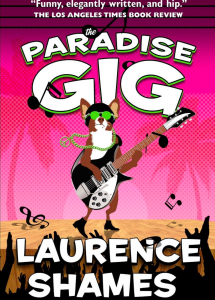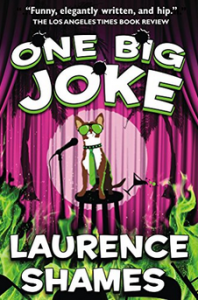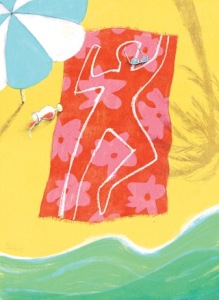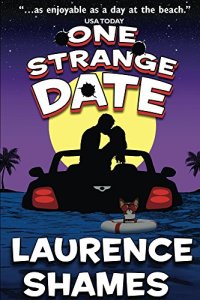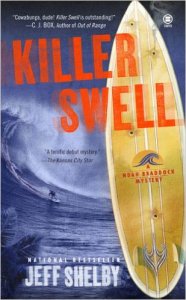 You could reasonably argue that our man Travis came out of a lineage of fictional tough guys that got its start in southern California. It was the stomping ground of two of the great originals of hard-boiled detective fiction—Philip Marlowe and Lew Archer. Currently the redoubtable PI Elvis Cole does his sleuthing there, as does the peerless police detective Harry Bosch. It seems to me, though, that those two don’t much resemble Trav. Cole cracks wise Spenser-style while Bosch stews and ruminates over existential questions. And there’s not much in the way of semi-tropical heat in the dour post-WWII worlds occupied by Marlowe and Archer.
You could reasonably argue that our man Travis came out of a lineage of fictional tough guys that got its start in southern California. It was the stomping ground of two of the great originals of hard-boiled detective fiction—Philip Marlowe and Lew Archer. Currently the redoubtable PI Elvis Cole does his sleuthing there, as does the peerless police detective Harry Bosch. It seems to me, though, that those two don’t much resemble Trav. Cole cracks wise Spenser-style while Bosch stews and ruminates over existential questions. And there’s not much in the way of semi-tropical heat in the dour post-WWII worlds occupied by Marlowe and Archer.
That’s not to say that authors don’t come along with California settings who try to capture the McGee vibe. A year and a half ago I wrote about Ron Ely’s efforts in that direction, with Santa Barbara tough guy Jake Sands. (That’s right, Ely the ex-Tarzan actor. Unfortunately, he wrote only two books in his promising series. It’s not easy, getting a genre fiction series established.) And this time around I’ll take a look at another southern California series. Jeff Shelby’s McGee wannabe is surfer sleuth Noah Braddock, who has had five outings so far.
One of the first impressions of Noah—who tells his tale in brisk, agile first person—is of a hero very comfortable in his own skin. While he may live to surf the beaches of San Diego, he likes nothing better than fighting the good fight, with lots of his own skin in the game. Just as Florida is a full-fledged character in most of the McGee yarns, San Diego and its environs are central to Noah’s story; he and the author clearly love the place, especially the surfing beaches. He has a sidekick who bears no resemblance to Meyer in look, style, or braininess—an even bigger surfer dude/tough guy called Carter. But Carter is as loyal and intrepid as they come and even takes a few bullets for his pal. There’s also a former girlfriend, a police detective, who’s in the cast.
The first book in the series, Killer Swell (2005), sees Noah take on a missing person case. Only this one is personal. The lost woman is his old high school girlfriend, Kate. He hasn’t seen her since they broke up toward the end of senior year, but he’s clearly carried the torch for her ever since. Her stuck-up, rich mother is the one who hires Noah; even though she hated him when he was dating her daughter. It turns out that Kate married a successful surgeon and they had what seemed a solid, prosperous marriage. Noah heads out to trace her known movements around San Diego before she disappeared. But his brief search ends tragically, when he finds Kate Crier in the trunk of a car, brutally murdered.
Bit by bit, Noah peels back the layers of deceit that had covered this supposedly golden girl. It turns out that she and her husband were both heroin addicts; though on and off. When Kate was pulled over by the police, they found dope in the car belonging to the husband. With a horrid deficit of chivalrousness, he let his wife take the very hard fall. And with that leverage, the DEA dragooned her into the investigation of a Mexican drug kingpin, for whom she ended up serving as a very unlikely mule. The natural conclusion is that the kingpin found out she was a traitor, had her killed, and stuffed into that trunk.
But when Noah—at great risk to life and limb—arranges a meet with said kingpin, the man delivers a surprise. Yes, he learned that Kate was collecting evidence for the DEA. And yes, he certainly would have killed her, given the chance. In his line of work, it would have been a professional necessity. But someone else got to Noah’s old flame before he did. He didn’t do it. And Noah believes him.
So, who killed Kate Crier and why?
In the meantime, Noah has to negotiate some secondary issues. He falls into the sack with Kate’s big sister, complicating his investigation. He also falls into the sack with the police detective, who needs him to stop interfering in her murder investigation. He has to deal with his friend and sidekick Carter, wounded in a shootout protecting Noah.
But, being stubborn and bent on vengeance, Noah bulls ahead and yet again almost gets himself killed, when he helps to take down the very unexpected murderer.
IMO, Killer Swell is more a straight PI mystery than something from McGee’s wheelhouse—despite some reviewers proclaiming Noah a new Trav. If McGee is a big turf ‘n’ surf dinner with a Boodles Martini, Noah Braddock is a akin to a nice beach-side hors d’oeuvre plate with an Amstel Light. There’s just not the substance and character that McGee brings to almost every situation he’s in. Noah, when it comes down to it, is kind of a superficial dude.
Don’t get me wrong. Shelby delivers a smooth, easy, entertaining read and I enjoyed it. If you’re in the market for a warm, semi-tropical crime story with a laid-back, free-spirit, first-person protagonist—and what reader of this blog isn’t?—you could do a lot worse.
While Shelby’s series is not bounteous, at five titles, it appears that he’s still adding to it. The most recent book was published just a year ago. The other four in the series are Wicked Break, Liquid Smoke, Drift Away, and Locked In. They’re all available as e-books.



